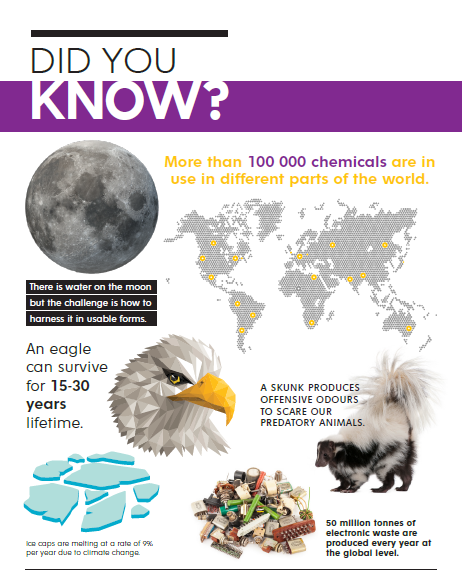The impacts of climate change have strained children’s educational programmes, mostly in developing countries due to their low coping mechanisms and being under resourced. Schools around the world are at the epicentre of extreme weather events, such as flash floods, cyclones, hail, strong winds, destroyed school buildings, learning materials, roads and bridges. These make it extremely difficult for school children to stay in school and continue to learn. For these reasons, Zimbabwean schools have made climate education part of the schools’ curriculum. Besides indoor learning activities, schools have also introduced climate protection activities in the form of environmental clubs. These clubs are aimed at cultivating, environmental participatory behaviour, stewardship, eco-living endeavours, resilient buildings and instilling environmental consciousness, at tender age groups. To catch them young, they say.
School children are very important stakeholders in the environmental discourse of climate change mitigation and adaptation, yesterday, today and future developments. This is done, not in isolation but within the framework of sustainable development goals (SDGs), particularly goals number 4 (Quality Education) and 13 (Climate Action). Schools have realized that quality education cannot only be achieved in the classroom rudimentary hence the need to marry theory with practice as they participate and showcase in a variety of clubs of their choice.
School children need to participate and be actively involved in communicating their own initiatives and raise awareness of environmental issues as part of their lifelong learning, skills-based practices and networks. This helps improve their knowledge, information base and local conditions. Therefore, it is the aim of these clubs that children’s participatory cultures and behaviours be able to promote environmental consciousness, green living, appreciation of surroundings, sustainable knowledge attainment and environmental stewardship. A variety of these clubs are aimed at conditioning children to participate in child friendly adaptation programmes through, composing, documenting and presenting poems on environmental conservation and climate literacy, record themselves and sharing them with the world via different social media platforms.
The school children are engaged in a variety of resilient building tasks like environmental debates, where they lock horns and compete annually for prizes. This is aimed at situating school children at the heart of sustainable developing, realizing that they are communicators of risk and drivers of change in their communities. Participating in environmental poetry, debates, songs, drama, games and schools’ related environmental projects, like tree planting, nutritional gardens, composting, among others, is the only way they can express themselves to the world as they are often marginalized from the official decision-making processes with regard to environmental conservation and management. Schools environmental clubs are of utter most importance because for quite a long time, environmental issues have been articulated from the adult perspectives leaving children to be mere passive participants and onlookers.
Children are not just participating in isolation but it is within their rights to participate as they are guided by the Convention on the Universal Rights of the Child. Furthermore, due to their vulnerability status to climate change, children need to be made a core-part of community-based initiatives. Children’s participation in environmental clubs, in the communities they live is always a child centred approach, according to their needs, desires and aspirations rather than child labour.
These environmental clubs are part of quality education, vital in playing a key role in giving children the knowledge and tools they need to mitigate and adapt to the impacts of climate change. This is to prepare them for the future on how to address the factors that cause environmental challenges. These are foundational skills necessary to prepare for the 21st century living. Children need to participate in schools’ environmental clubs more because they are currently faced with numerous environmentally related problems such as the Covid-19 pandemic and climate change and variability induced disasters.
The Covid-19 pandemic and the natural disasters drove many families into isolation, poverty and starvation as many stopped working or were denied the chance to hustle and eke a living. In this regard, children were the most affected, not only physically but also educationally, psychologically, socially and mentally. This affected their chances to play outdoors, engage in childhood games, interacting with nature as a natural laboratory and marrying theory to practice.
For these reasons, UNICEF estimated that, about 150 million children have been driven into poverty. This was due to volatile, erratic and half-backed schooling itineraries since the start of the pandemic in 2020. Lack of active schooling, play and games, especially outdoors meant that, there was the diminishing of child friendly environments, the element of play and games, not only games in general but also green games, with many intrinsic motivations and sustainable co-benefits. Environmental or green games are designed for learners to solve and overcome environmental challenges they encounter in life. Games that promote environmental consciousness, were missed by learners. These games have the greatest potential to educate, inform and inspire children to appreciate their environment as the natural laboratory and cradle of learning.
Children also need to participate in reading clubs in order to fight against the death of the reading culture. The yester year culture of reading has been gradually affected by new media technologies hence reading clubs would help to revive the dying community of practice. In this regard, reading becomes powerful and purposeful, where children not only read to learn but also about nature and everyday life including enjoyment.
It is also important and significant for schools to note that, besides environmental debates and participatory cultures, they need to go a step further and organize environmental expos, where children can show case their creativity and innovations as ways of safe guarding and realizing resilience.



